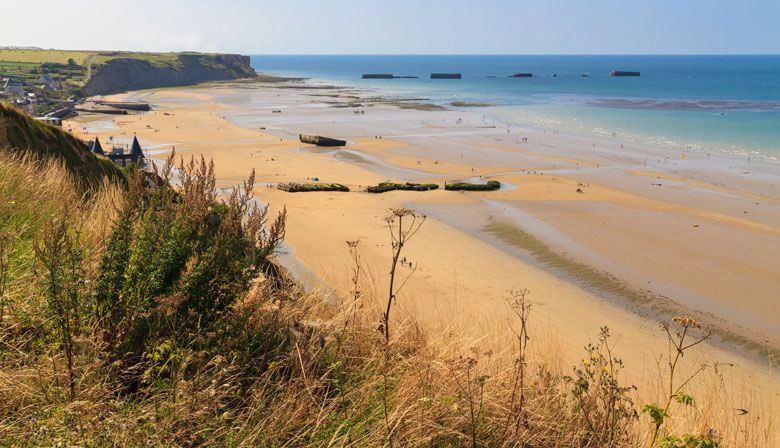Saint-Malo
The city of Saint Malo has been witness to some of the greatest names in France’s history; Jacques Cartier, Robert Surcourf and François-René de Chateaubriand are just some who contributed to the legend that is Saint-Malo. Just a few hours away from Paris, Brittany and its charming life has never been so close ! You want to visit this town ? Some Normandy tours include Saint-Malo too.

Forts and Ramparts
The first thing you can’t help but see when you get to Saint-Malo is it imposing fortified walls. With more than 1,700 meters of ramparts, all of which has been registered as a historical monument in 1921, the citadel is well-protected -- and protects well! The part of Saint-Malo that’s located within the ramparts is called intra-muros. It’s in this historic zone that visitors find the largest number of restaurants, cultural sites and boutiques. The gates, bastion, and Bidouane Tower are all open to the public.
The dyke and beaches are also treasures that contain their own surprises. Look out toward the Atlantic Ocean, and there you’ll see the National Fort and the islands of Petit Bé and Grand Bé. The latter is home to the tomb of the famous Saint-Malo writer, Chateaubriand. If you walk along Sillon Beach, you’ll be able to admire the sea from the dyke and stop off at the renowned thermal baths of Saint-Malo.
Treat Yourself to Seafood, Crêpes and Ice Cream!
If you’re looking to try a bit of all the region’s specialities, Saint-Malo is the place to be in Brittany. There are loads of crêperies, seafood restaurants and delicious butter cakes. Meals can be enjoyed at Sillon Beach by reserving a table with view at the Brasserie du Sillon, located on the seawall. More inland, you’ll go crazy for the yummy candies at the Maison Guella that has been fabricating famous salted-butter caramels and traditional cookies since 1920, both the pride of the region. Go on and give in to the tasty treats known as gwelladous, a yummy snack that pairs nicely with a savory spread.
But don’t leave Saint-Malo without tasting the delicious ice cream flavors -- like Kouign Amann -- at Chez Sanchez or stopping by the Maison du beurre Bordier to taste some Baratte butter that your taste buds certainly won’t forget!
Saint-Malo during WWII
Two months after D-day, American troops arrived at Saint Malo to liberate the city (located about 200 kilometers from Omaha Beach). The Normandy region now under control, the Allied troops headed to Brittany to defeat the Germany Army, present in France since 1940.

The Liberation of Saint-Malo
The success of the Battle at Normandy caused German troops to retreat to Brittany. Initially, Saint-Malo wasn’t considered a target due to its weak garrison numbers. However, the number of German soldiers posted to Saint-Malo thereby increasing their numbers to a total of 13,000 troops.

© Flickr / PhotosNormandie
The strikes led at Saint-Malo and Dinard were more difficult than planned, and an Allied offensive on August 6 was a disastrous failure. In addition to its garrison inside the city walls, Saint-Malo also benefited from artillery on the island of Cézembre that was capable of reaching land troops. Thanks to efficient artillery firing against the Germans, American soldiers managed to infiltrate the city on August 9. Troops surrendered to the 330th infantry regime and, short on ammunition, the Germans could no longer defend themselves.
A City Greatly Affected by the Allied Landing
Today, intramural Saint-Malo is very well-known for its medieval homes and walk on top of its ramparts. The city is in large part reconstructed; the majority of the historical center was destroyed during fierce fighting. On August 6, 1944, the American Army bombed the city whose reconstruction would last until 1972 with the restoration of the Saint-Vincent Cathedral. The National Fort located in the Saint-Malo Bay also suffered material and human losses among the inhabitants of the corsair city.
Remnants of the Landing
The city of Aleth, which faces Saint-Malo, was also occupied by German soldiers who, despite heavy bombing, surrendered on August 17, 1944. There, a 17th century fortress was built under the initiative of the Marquis of Vauban who judged the area to be a zone at risk of attack and thus essential in protecting Saint-Malo. Renovated throughout the 19th century to house a battery of artillery, the fortress hasn’t been used since 1914.
During American attacks to liberate the city, German troops took refuge in bunkers that were installed at the fortress at the beginning of Occupied France. Today, the fortress has been turned into a museum, Memorial 39-45. Created in 1994, it retraces the history of Saint-Malo during WWII.
The city of Saint-Malo is a natural fortress whose islands and peninsulas have become difficultly seizable fortresses over the centuries. Did you know, for example, that the National Fort has never been seized by anyone?


